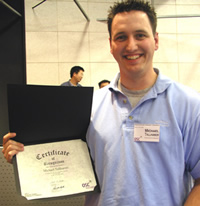 Michael Tallhamer, a graduate student at Cleveland State University’s Department of Chemistry and Physics, received the OSC Graduate Conference Student Achievement Award during OSC’s Graduate Student Workshop and Conference held on August 8 and 9.
Michael Tallhamer, a graduate student at Cleveland State University’s Department of Chemistry and Physics, received the OSC Graduate Conference Student Achievement Award during OSC’s Graduate Student Workshop and Conference held on August 8 and 9.
Tallhamer was awarded for his computational investigation of tetrahydrobiopterin’s role in the electron transfer of nitric oxide synthase. His research involves understanding how electrons move around in nitric oxide synthase, an enzyme that promotes the formation of nitric oxide (NO) in the body.
“The nitric oxide synthase (or NOS) that Mike is modeling is one of three related enzymes that participates in NO formation,” said David Ball, Chemistry Professor at Cleveland State University and Conference Chair. “Learning how this huge protein works and exactly how it promotes NO formation will give us a better understanding of how and why NO itself works. For future applications, we might be able to synthesize new compounds that can be used to treat ailments related to NO dysfunction.”
Tallhamer said he was very surprised when he was presented with the award. “After the initial shock wore off, I felt as anyone else would have; I was honored to be recognized amongst my peers and one of my professors, Dr. Ball, for my research,” he said. “I was particularly happy, that my wife was able to drive down and see me that day for my presentation. To receive the award with her there made it even better.”
“Mike is an excellent student,” said Ball. “He's latched on to a fascinating project as well. The combination of these two things bodes well for Mike's future.”
Tallhamer said this year’s graduate conference was by far one of the best he’s ever attended. “It not only allowed me to interact with researchers from various fields, including my own, but also made me aware of the variety of tools that OSC has made available to researchers in need of high-speed computational resources,” he said.
Tallhamer worked with OSC prior to the conference as an undergraduate student but was amazed to see the many other aspects of OSC while at the conference. He commented, “I especially enjoyed learning about OSC’s data visualization capabilities, as it has direct application in my research, and OSC’s willingness to provide training on the visualization software, which I hope to take full advantage of in the future.”
“I guess you could say that what I truly learned from the conference was exactly how much OSC has to offer a researcher,” he said.